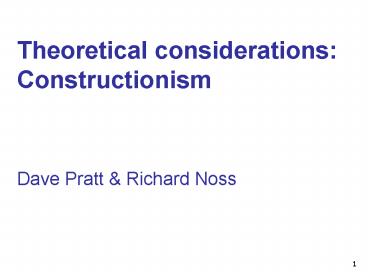Theoretical considerations: Constructionism Dave Pratt - PowerPoint PPT Presentation
1 / 23
Title:
Theoretical considerations: Constructionism Dave Pratt
Description:
What's constructivism? what the student knows already matters ... shares constructivism's connotation of learning as 'building knowledge ... – PowerPoint PPT presentation
Number of Views:62
Avg rating:3.0/5.0
Title: Theoretical considerations: Constructionism Dave Pratt
1
Theoretical considerations Constructionism
Dave Pratt Richard Noss
2
What's constructivism?
- what the student knows already matters
- students construct their own meanings
- construction is an active process
- teaching isn't the same as learning
- learning isn't the same as understanding
3
What are the educational implications of
constructivism?
- student control
- students' knowledge matters
- purposeful activity
- a sense of satisfaction and competence
4
constructivism isn't really a theory of
instruction
5
- Constructivism
Constructionism
6
What is constructionism?
7
Learning by making
- Constructionism ... shares constructivism's
connotation of learning as "building knowledge
structures" irrespective of the circumstances of
the learning. It then adds the idea that this
happens especially felicitously in a context
where the learner is consciously engaged in
constructing a public entity (Papert)
8
Instructionism v constructionism
- looks like a split about strategies for
education two ways of thinking about the
transmission of knowledge. But behind this there
is a split that goes beyond the acquisition of
knowledge to touch on the nature of knowledge
and the nature of knowing. (Papert)
9
modify our notions of complexity and hierarchy?
- complexity often inheres in the infrastructure
as much as in the idea itself - a shared experience and discourse
- cultural artefacts (pizza)
10
transform the social embedding of the knowledge?
- some mathematical ideas are amenable for the
first time to those who may not otherwise have
encountered them - much larger numbers of people need to develop
techno-mathematical literacies to make sense of
mathematisation of working and social life
11
levels of theory
- broad theories of learning
- constructivism or behaviourism
- broad theories of teaching
- constructionism or instructionism or...
- domain specific
- how to learn about motion...
12
The History of Constructionism
- Papert and Feurzig MIT team in 1960s researched
problem solving - Can elementary school students learn to program?
- What is the relationship between programming and
maths? - What is the relationship between programming and
cognitive style? - How can we evaluate the work?
13
The History of Constructionism
- Radical idea that playing with a computer might
precede learning formal mathematicsWhen
mathematizing familiar processes is a fluent,
natural and enjoyable activity, then is the time
to talk about mathematizing mathematical
structures, as in a good pure course on modern
algebra. (p. 18)Papert, S. (1972). Teaching
Children to be Mathematicians Versus Teaching
About Mathematics. International Journal of
Mathematics Education and Science and Technology,
3, 249-262.)
14
The History of Constructionism
- Mindstorms put forward fundamental challenges to
the education world.Papert, S. (1982).
Mindstorms Children, Computers and Powerful
Ideas. London Harvester Press.
15
- papert's gears
16
Principles in Constructionism
- The Power Principle (Using before knowing)
- Project before problem
- Media before content
- Object before operation (Thingness)
- Dynamics before Statics
17
The Instructors approach
- How to construct a perpendicular bisector of a
line segment. - Place your point of your pair of compasses on one
end of the line segment and draw a circle whose
radius of more than half the length of the
segment - Repeat, placing the point at the other end of the
line segment. - Join up the two points where the circles
intersect.
18
The Motivators approach
- There is a 3m line drawn on the floor.
- I want all the girls to stand 2m away from that
end of the line - and all the boys 3m from the other end.
- Now, lets stretch this ribbon between the two
points where the boys and girls are both standing.
19
The Facilitators approach
- Here is a new program called Cabri Geometry.
- I want you to explore the menus and then
construct the perpendicular bisector of a line
segment. You choose the line segment.
20
The Constructionist approach?
- The Primary Laptop Project story
Pratt, D.C. Ainley, J., (1997), The
Construction of Meanings for Geometric
Construction Two Contrasting Cases,
International Journal of Computers for
Mathematical Learning, 1.3, 293-322, Dordrecht,
Netherlands Kluwer Academic Publishers.
21
Two microworlds (?)
- Visual Fractions
- Developed by Ivan Kalas and his team at the
Comenius University, Bratislava and published by
Logotron Ltd - Magic Forest
- Developed within the Playground Project and
published by Logotron Ltd and Ctnotinfor
22
Task 1
- Play with Visual Fractions or Magic Forest.
Could you use this microworld with children in a
way that the activity satisfies the principles
of - Using before knowing (Power)
- Project before problem
- Media before content
- Object before operation (Thingness)
- Dynamics before Statics
23
Task 2
- Discuss how might the notion of constructionism
impact on classroom activity with or without the
use of computers?

